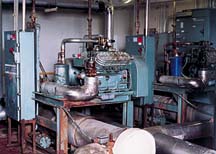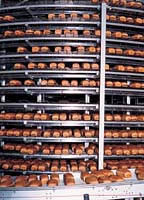
In fact, an association that represents the bakers and the EPA negotiated a "voluntary partnership" that would reduce EPA enforcements and fines for bakeries if they moved from an HCFC like R-22 to an HFC. While many bakeries with leak-tight R-22 systems stayed with the HCFC, others looked to HFCs.
This brings us to a continuous production bakery in Florida. It had R-22 equipment less than 10 years old that apparently was in good working order, but the owners wanted to avoid any possibility of hefty fines from inadvertent leaks.
So the owners called Alderman Refrigeration Inc., Plant City, Fla. Alderman had maintained refrigeration systems at the bakery for many years.
According to Doug Alderman, the system had sufficient capacity to allow a fairly easy conversion to an HFC. A smooth conversion was critical because the bakery runs continuously to supply stores, restaurants, and institutional food service operations throughout central Florida. Any downtime would mean a substantial loss of revenue.

The Equipment
The facility had eight refrigeration units, which all ran on R-22. There were four Thermitrol open-drive chillers and four Chester-Jensen plate chillers."When I laid out the specifications for the system, I built in extra capacity so we wouldn't have to change out a compressor in the middle of the night," said Alderman. "We had enough condenser capacity to make the switch to an HFC refrigerant with no equipment change."
Alderman used HFC-404A (packaged here as Forane® 404A) in conjunction with polyolester (POE) oil for the four cold-temperature machines.
The bakery returned to full production when the conversion was completed, said Alderman. "The machines are running ahead of the load instead of behind it. One of them is even cycling during a run, which never happened with R-22. We have three 50-horsepower compressors and one 30-horsepower compressor on this line. By reducing the operating time of the compressors, we are saving money through reduced power demand."
The remaining units will be switched to 404A in the future. "R-22 was good, but it seems the 404A is moving more heat than the R-22 and more efficient on power. I'm impressed with it."
Alderman admitted some concern over POE oil. "We heard things a few years ago that made people scared of POE. Yet we have had no seal failures. We added a high-capacity filter on the liquid line and an in-line filter from the separator to the compressor."
"We are aware of the issues and concerns our customers must address when confronted with a refrigerant retrofit decision," said Ricketts. "That is why we have spent much time working with the original equipment manufacturers to thoroughly test and approve all our refrigerants including 404A, 507, 407C, and 410A.
"We are having great success with both 404A and 507 in replacing R-22 in low- and medium-temperature applications. The issues of oil change-out and compatibility have been resolved.
"With the observed improvements in performance and efficiency, these new HFC refrigerants are quickly taking over the market."
For more information, visit www.atofinachemicals.com or www.forane.com.
Publication date: 12/01/2003


Report Abusive Comment